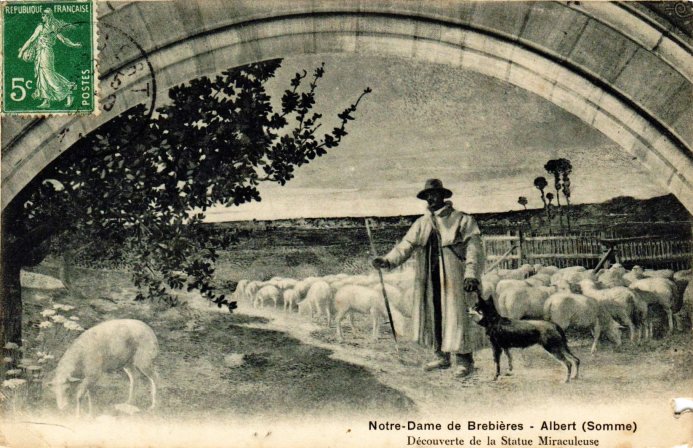

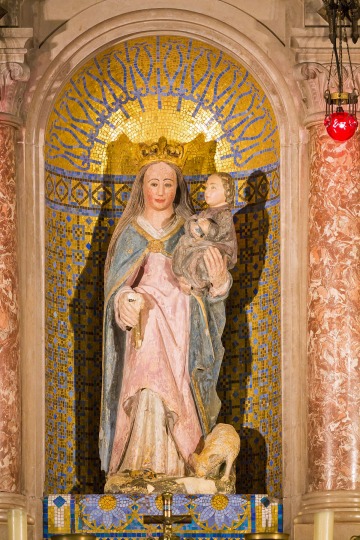 Also called Mother of the Good Shepherd and the Divine Shepherdess, devotion to Our Lady under this title has two main sources.
The oldest of these is the shrine of Notre-Dame des Brebières in Albert, France. The word Brebières appears to be a
combination of brebis (French for ewes – female sheep) and bergères (French for shepherdesses).
Also called Mother of the Good Shepherd and the Divine Shepherdess, devotion to Our Lady under this title has two main sources.
The oldest of these is the shrine of Notre-Dame des Brebières in Albert, France. The word Brebières appears to be a
combination of brebis (French for ewes – female sheep) and bergères (French for shepherdesses).
It was probably in the twelfth century, according to local tradition, that a shepherd was grazing his sheep near Albert when he observed that many of the animals were staying in the same area to eat, ripping the grass out by the roots. It must have seemed very odd to the shepherd, who decided that the sheep were trying to uncover something, so he started to dig in the very spot himself. In a short time he uncovered a statue of the Blessed Virgin sculpted from a single piece of solid stone. The statue was fairly large, nearly four feet tall, and represented the Blessed Mother holding the Divine Child in Her arm. There was a sheep depicted quietly reclining at Mary's feet. As has happened so often throughout history, the finding of the statue increased the enthusiasm and affection of the local populace toward the Mother of God. A small chapel was built at the site to honor the statue and receive the pilgrims who had already begun coming to Albert to visit the statue.
Saint Colette can be credited for helping to spread the fame of Our Lady as the Divine Shepherd at Brebières. At age fourteen she was somewhat short and had a delicate constitution. Seeking a remedy through the favor of the Blessed Virgin, Saint Colette prayed to Our Lady of Brebières. She not only obtained vigor and good health, she also found that several inches were miraculously added to her height.
In 1637 the sanctuary was partially burned, and the miraculous image was moved to the parish church of Albert in 1727.
During the French Revolution the church was made into a pagan temple to the goddess of reason,
while the image of the
Mother of God was hidden until 1802 when the horrors of the Terror during this supposed time of reason
subsided.
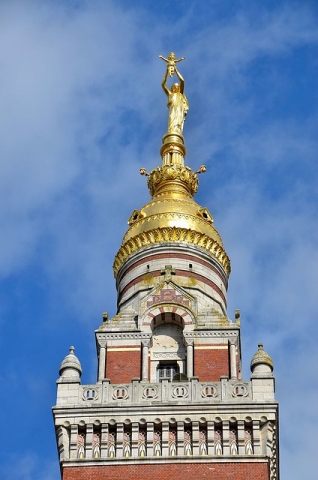 In 1834 Pope Gregory XVI noticed the growth of the devotion towards the statue and approved of a larger church being built at the location.
Finally, construction on the Basilica of Our Lady of Brebières began in 1885 and lasted until 1897. A new large statue of Marian Art
entitled The Golden Virgin was attached to the top of the dome. In 1901 Pope Leo XIII named the church a minor basilica,
ordered the original statue to be crowned, and called the Basilica the
In 1834 Pope Gregory XVI noticed the growth of the devotion towards the statue and approved of a larger church being built at the location.
Finally, construction on the Basilica of Our Lady of Brebières began in 1885 and lasted until 1897. A new large statue of Marian Art
entitled The Golden Virgin was attached to the top of the dome. In 1901 Pope Leo XIII named the church a minor basilica,
ordered the original statue to be crowned, and called the Basilica the Lourdes of the North.
By 1910, The Golden Virgin was a prominent landmark atop the basilica, and was used as such in the sixth stage of the
Circuit de l'Est. Two pilots, Alfred Leblanc and Émile Aubrun, used the sculpture as a compass and it was referred to in a news
article as the famous Golden Virgin.
In August 1910, one of the pilots, Aubrun, flew circles around the sculpture with his
Blériot XI aircraft in order to get a closer look. When asked about his laps around the statue he said, Not having occasion to see
such a sight every day, I made the best of it and examined the statue from near at hand making several circles round it.
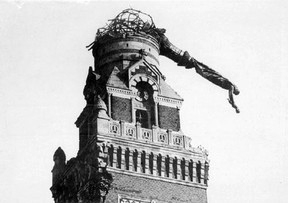 In 1914, World War I had begun
and 80 percent of the German Army had mobilized and were positioned on the Western Front. By the end of 1914, German troops held strong defensive
positions inside France. In that same year, German forces suspected a French observation post was housed in the church's bell tower,
so beginning in October 1914, they shelled the dome. In 1915, during the Battle of the Somme, the sculpture was shelled and left leaning at an angle
of more than 90 degrees to the vertical axis.
In 1914, World War I had begun
and 80 percent of the German Army had mobilized and were positioned on the Western Front. By the end of 1914, German troops held strong defensive
positions inside France. In that same year, German forces suspected a French observation post was housed in the church's bell tower,
so beginning in October 1914, they shelled the dome. In 1915, during the Battle of the Somme, the sculpture was shelled and left leaning at an angle
of more than 90 degrees to the vertical axis.
By January 7, 1915, the dome was destroyed and by January 21, the base of the statue was hit and the statue tilted alarmingly.
Although artillery shells destroyed much of the town of Albert, the statue of Mary remained attached to the Basilica but was tilted at an extreme angle.
Many soldiers studied the sculpture daily; they wrote about it in their diaries and remarked that it was knocked over and threatening to fall at any time.
Messages about the statue were passed between troops; it was often said to be a portent; When the Virgin falls, the war will end.
Soldiers also said whoever knocked down the statue would lose the war.
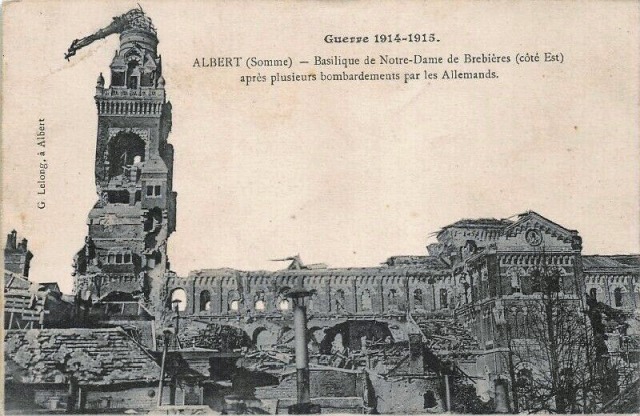
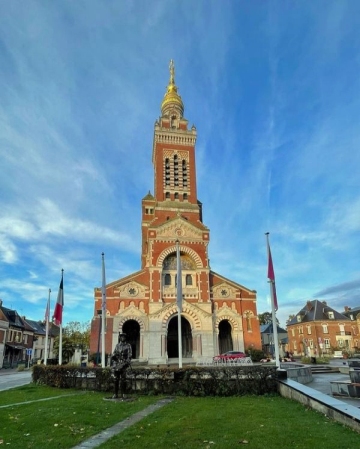 The statue became a symbol to both British and German troops; soldiers remarked the Virgin Mary was keeping the baby Christ from falling.
On March 27, 1918, The Golden Virgin was at the center of the fighting. During the night an intense moonlit battlefield allowed the Germans to target
British troops and target the sculpture. German troops occupied the city of Albert in 1918, and the British shelled the Basilica in order to deprive
the Germans of the elevated position, and the statue was toppled. It was never recovered. By September 28, 1918, the sculpture was reported to have
fallen and only partial walls of the Basilica were left standing. The shelling from both sides destroyed the building, including the crypt.
German troops also set clockwork bombs which were timed to explode three weeks after they left. Coincidentally, World War I ended on November 11, 1918.
The statue became a symbol to both British and German troops; soldiers remarked the Virgin Mary was keeping the baby Christ from falling.
On March 27, 1918, The Golden Virgin was at the center of the fighting. During the night an intense moonlit battlefield allowed the Germans to target
British troops and target the sculpture. German troops occupied the city of Albert in 1918, and the British shelled the Basilica in order to deprive
the Germans of the elevated position, and the statue was toppled. It was never recovered. By September 28, 1918, the sculpture was reported to have
fallen and only partial walls of the Basilica were left standing. The shelling from both sides destroyed the building, including the crypt.
German troops also set clockwork bombs which were timed to explode three weeks after they left. Coincidentally, World War I ended on November 11, 1918.
According to a November 23, 1918 report in The Bellman: It was the tradition of the French peasants that when the Virgin fell the war
would come to an end. It is said that an Australian gunner finally brought it down. At any rate, when the Germans were beaten back at the beginning
of the last Allied offensive and Albert was retaken, the tower and statue had fallen in ruins. The peasants believe that the luck of the Germans had
deserted them when the Virgin of Albert fell. From that day the power of the enemy waned, and this leaning statue certainly marked the high tide of
the German invasion.
Residents discussed replacing the sculpture in its famous wartime pose but later decided to replace it in its original standing pose. The sculpture of The Golden Virgin was recast in 1929 and fitted atop the nearly 250 foot tall bell tower during the reconstruction of the Basilica.
A proper Mass in honor of Our Lady, Mother of the Divine Shepherd was inserted in that part of the Missale Romanum which contains
Masses for various places.
The date given is September 3.
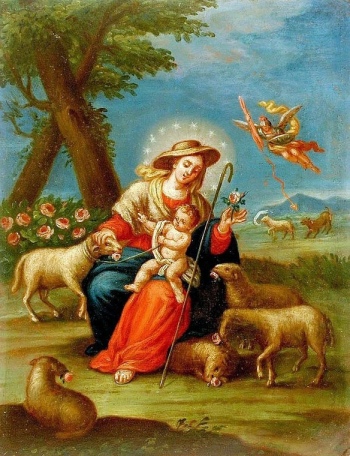 Of more recent origin is the devotion to Our Lady, Mother of the Good Shepherd, or the Divine Shepherdess (Divina Pastora) promoted by
the Capuchin Order.
Of more recent origin is the devotion to Our Lady, Mother of the Good Shepherd, or the Divine Shepherdess (Divina Pastora) promoted by
the Capuchin Order.
In the year 1703, Friar Isidore of Seville, a great popular preacher, was inspired to be accompanied in his mission by a banner with a particular
representation of the Virgin Mary: dressed with the humble clothes of a shepherdess, sitting on a rock, under a tree, wearing an ordinary wide-brimmed hat
(sombrero), and with some lambs portrayed around Her. Certainly, this image was in stark contrast to numerous exuberant images of the Virgin used at the time,
represented with very sumptuous costumes, splendid crowns and imposing thrones. The Capuchin preacher could sense that the simplicity of the Mother of God,
so close to all of Her children – and especially Her concern for the estranged sheep – would give to his words a particular success and additional help
to touch hearts to come back to God. As a matter of fact, all this indeed took place and the devotion to the Shepherdess of souls,
which popularly
became known as the Divine Shepherdess,
expanded rapidly with the creation of many groups of the faithful linked to Her throughout Spain.
They became known as Mary's Flock. Obviously, there were those that could not accept to see Our Lady represented in such a manner, so poor and simple
(saying that Her clothing had no decorum
), but the popular sentiment that rapidly became identified with this new version of the Mother of Mercy triumphed,
winning over people's hearts.
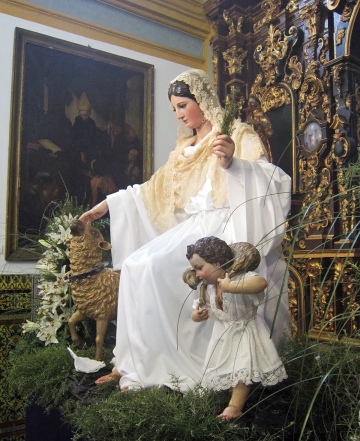 Friar Isidore attempted to obtain ecclesiastical approval for this devotion in many ways. He received from Pope Clement IX (1700-1721) two bulls that granted,
on the one hand, that the altar where the image of the Divine Shepherdess was venerated should be a privileged altar, and on the other, that the fraternities of
Friar Isidore attempted to obtain ecclesiastical approval for this devotion in many ways. He received from Pope Clement IX (1700-1721) two bulls that granted,
on the one hand, that the altar where the image of the Divine Shepherdess was venerated should be a privileged altar, and on the other, that the fraternities of
Mary's Flock
receive all the indulgences and privileges that were granted to other such associations. The bull, however, did not explicitly approve the devotion.
With his death, which occurred in 1750, for some years this devotion was in a certain sense orphaned. However, it found in Blessed Diego de Cádiz (1743-1801)
a fiery propagator, who claimed that he received the gift of preaching through the Divine Shepherdess. He was responsible for writing the appropriate
liturgical texts for the celebration of the Mass and the Divine Office for this devotion. These writings received the approval of Pope Pius VI in 1795,
thus sealing the devotion canonically. As a result, the Spanish Capuchins were now able to celebrate each year the liturgical recurrence of the
Feast of the Divine Shepherdess on the Saturday before Good Shepherd Sunday – the Second Sunday after Easter.
In 1798, also as part of the efforts of Blessed Diego, a decree of the provincial leadership ordered the placement of Her image in all the churches of the Order and proclaimed Her the Patroness of the Spanish Capuchin missions. Her devotion spread throughout Spain, through the missions in Latin America and also in many parts of Italy that were under Spanish influence. In 1885, Pope Leo XIII extended this feast day to the entire Order.
Additional Article on Our Lady of Guadalupe
Alphabetical Index; Calendar List of Saints
Contact us: smr@salvemariaregina.info
Visit also: www.marienfried.com